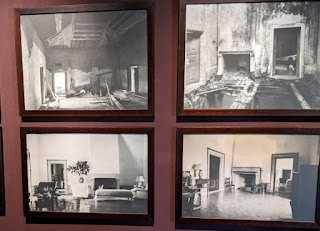We set off in a bus to see more of Lisbon and ended up with a walking tour of the old downtown parts of the city. It is reminiscent of San Francisco in that it is built on hills, has a tram system, and was devastated by an earthquake and tsunami in 1755. Our first stop was a park (with lots of somewhat aggressive vendors --if you showed interest in something, they followed you around, but if you ignored them, they returned the favor). This is the location of the Torre de Belem which also had a replica of the first plane to cross the Atlantic at its widest. The tower has several animals depicted on the corners, including the first rhinoceros to set foot in Europe since Roman times. It was a gift from India to Portugal, it had a short and sad life there.
 |
A huge grain silo across the bay with cranes for loading
and unloading.
|
 |
A replica of the seaplane that made the historic trip in
1922. They made several stops along the way and used
three different planes in a trip that took 2.5 months,
mostly due to waiting for replacements.
|
 |
The Torre de Belem is a small fort at the entry to the
Tagus River in Lisbon, built in the 16th century.
|
|
 |
The fort in the distance is currently
a lighthouse.
|
 |
The rhinoceros sculpture is badly eroded limestone.
|
 |
Above and two below: other sculptures on the corners.
|
Looking inland from the tower, you can see a bridge that is a close replica of the Golden Gate Bridge (minus the Art Deco style) and a statue reminiscent of the Rio De Janerio Christ the Redeemer statue. The bridge opened in 1966 and was originally named for Salazar, the dictator, and was renamed for the date of his overthrow in 1974. In 1999, they added a lower deck for a train, which was originally in plan, but constructed later. The bridge had first been proposed in 1935 and designs submitted including on from the eventual builder. When they decided a second time to build it, one of the original design teams won. They were from the US and had connections to the construction of the Golden Gate.

The next site we visited was a statue celebrating Henry the Navigator and many of the intrepid folks who explored the world for Portugal..It is called the Monument to Discoveries and was originally built in 1935 for the Portuguese 1940 Expo. Like many such structures, it was not built to last and was demolished and rebuilt in 1958. Henry wasn't really a navigator, but he sponsored the age of discovery.
 |
Map of the world showing Portuguese discoveries.
|
After that, we headed to the old part of town, Alfama. It is famous for a type of music called 'fado' played on a 6 or 12 string guitar that uses a totally different tuning plan than a modern guitar. The streets were narrow and in the early stages of being decorated for some big festival that starts in several weeks. We also got an opportunity to try a cherry liqueur called Ginja that apparently is served in little chocolate cups. Talk about heaven!
 |
Our refreshment break!
|
 |
Tiles representing the Fado culture - not
considered a high-brow form of
entertainment.
|
 |
Decorations on this apartment building also
related to Fado
|
 |
The metal plate on the street is where
a wall once was.
|
|
Then we walked up to the Lisbon Cathedral, originally built in 1147 and renovated and rebuilt and added to several times since then. Tile is also a very big thing in Lisbon and has led to theft. People will pull tiles off an old building and market them as antiques. The pictures below are majorly out of sequence but disappear if I try to move them.
 |
The front of the Cathdral, which is up a
long hill
|
 |
This is how far up we have walked from
sea level. There is a nearby elevator to
ease the ascent from below.
|
 |
One side of the cathedral, showing an old section
|
 |
Above and below: samples of building
tiles.
|
 |
Above and below: the oldest visible sections of the cathedral.
|
Nearby is a church dedicated to Santo Antonio who is supposed to be the patron saint of lovers. If you are able to throw and land a coin in his book in the statue in front of the church, you will find a new (or better) partner. The museum dedicated to him had a large display of plates of varying sentiments related to his help.
After lunch we walked back to the hotel and got back just in time to meet up with a friend who now lives in Lisbon. She was a docent with me for the Chinese Culture Center and used to split her time between San Francisco and Lisbon until about 12 years ago, she moved permanently to Lisbon. We had a fun time catching up and comparing pandemic stories.
















































